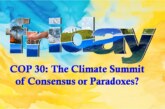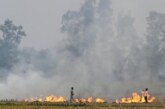
Dr. Arvind Kumar*
Water is a limited and irreplaceable resource, yet its demand continues to rise relentlessly due to population growth, urban expansion, and industrialization. Unlike energy, where advancements have led to the discovery and deployment of alternative sources such as solar, wind, and hydrogen, there exists no substitute for water—an essential element for all forms of life. This makes its scarcity not only a developmental challenge but a fundamental threat to human survival and ecological stability. What is even more concerning is that the infrastructure responsible for storing, treating, and distributing water is severely overburdened and aging. Much of it was not designed to handle today’s levels of consumption or the increasing impacts of climate change such as erratic rainfall, prolonged droughts and heatwaves. As we wait for rains to get a respite from heat As we wait for rains to get a respite from heat the annual tradition of urban flooding awaits us Rapid urbanization, coupled with poor planning, has led to the degradation and loss of natural water bodies that once absorbed excess rainwater. As their capacity to manage runoff diminishes, flood risks intensify. When this loss is compounded by inadequate drainage infrastructure and the growing impacts of climate change, it creates a volatile mix that makes urban areas increasingly vulnerable to seasonal flooding. The encroachment of urban water bodies is a major driver of recurring monsoon floods in cities like in Chennai, Bengaluru and also Delhi.
To what extent is the current legal and policy framework sufficient to prevent the destruction/encroachment of urban water bodies? Where are the gaps?
How can urban planning be redesigned to prioritize the preservation and restoration of natural water bodies?
Although we talk about integrated river basin management but we forget about wetlands. Wetlands play a vital role in delivering essential ecosystem services that enhance human health, well-being, and environmental sustainability in a cost-effective way. They support key ecological functions such as recharging groundwater, regulating water flow, and storing carbon, while also serving as crucial habitats for wildlife. Acting as a natural bridge between built and natural environments, wetlands contribute to flood mitigation, wastewater purification, and fisheries production. Their preservation and effective management are closely linked to achieving several Sustainable Development Goals, especially SDG-6 (clean water and sanitation), SDG-11 (sustainable cities and communities), SDG-13 (climate action), and SDG-14 (life below water).
India is poised to see significant rapid urbanisation in the coming years, with over 50 percent of its citizens expected to reside in urban areas by 2050. India’s ability to fulfil its climate and net-zero commitments will depend on how it governs its existing and emerging cities, including making them livable for urban residents (for instance, by tackling hazards like flooding and heatwaves). Recent flood events in cities across India have highlighted the mismanagement of water resources, with the idea of economic growth driven by real estate value addition superseding ecological considerations.
Appropriate Rules and Guidelines?
With the advent of the wetland’s guidelines for the implementation of wetlands rules 2017 around 757,000 wetlands with a total wetland area of 15.3 million ha, accounting for nearly 4.7% of the total geographical area of the country were identified. Wetland loss needs to be seen not just as a biodiversity crisis, but as a development crisis, which could lead to more water, food and climate insecurity. As member hydrology of the national wetlands committee of the Ministry of Environment Forest and Climate change, Government of India while drafting the guidelines for the implementation of the wetlands rules 2017 we asserted that a transformed response to address rapid wetlands degradation and loss would be to pursue the integration of wetlands, and their wide-ranging values, within developmental programming at various levels and bring role of state wetlands authorities to the fore for wetlands conservation.
Government of India especially Ministry of Jalshakti and NMCG are already being proactive in sustainable wetland management, Ministry of Environment Forest and climate change is also engaged in it and so is the ministry of Earth Sciences. In addition, while the state wetland authorities (SWA) are the nodal agencies for wetland management in each state, multiple state and central agencies have wetlands under their jurisdiction despite wetland management not necessarily being a part of their agenda. For example, wetlands in Delhi are under the jurisdiction of the Delhi Jal Board, Delhi Urban Shelter Improvement Board, Public Works Department, Archaeological Survey of India, and Forest Department, but only the Forest Department and Delhi Jal Board have any expertise in wetlands management.
Importantly, administrative and judicial reforms at the state and national levels may also be required to consolidate the governing mechanism for wetlands in the country. Across India, multiple departments and agencies oversee wetlands and water bodies, with many lacking environmental and water governance expertise. This leads to mismanagement, faulty policymaking, and the encroachment of wetlands. India should establish a nodal wetland governing agency to proactively manage the wetlands currently under the jurisdiction of multiple agencies. What we need is an integrated approach of various ministries to achieve the goal by strengthening our efforts and strengths, to have collective action between governments, business, UN, international organizations, NGOs, development and doner partners, local communities to ensure the long-term sustainability of water and wetlands, and the global economy.
In the guidelines we linked the wetlands to revenue records which further lead to more wetlands cropping up through GIS mapping and more by removing encroachments. The guidelines clarified that all wetlands, irrespective of their location, size, ownership can be notified under the Wetlands Rules 2017. Well preserved wetlands also contribute to social cohesion and economic stability by ensuring livelihood and to preserving cultural identity.
Way Forward
It is essential that India’s urban growth is steered by sustainability and ecological resilience, with active involvement of all relevant stakeholders. Urban policies must integrate actionable climate strategies that promote innovative concepts like blue-green infrastructure—which blends urban development with the preservation of natural assets such as waterbodies and green spaces—and the sponge city model, which emphasizes the crucial role of wetlands and waterbodies in absorbing stormwater and enhancing urban flood resilience. India must prioritize the conservation of vital urban natural resources, particularly wetlands, within its urban governance framework. The outcome document from the July 2023 G20 Environment and Climate Ministers’ meeting—held under India’s presidency—highlighted the urgent need to prevent and reverse water degradation through wetland restoration. It recognized wetlands and other water bodies as natural carbon sinks critical for climate change mitigation. India must now translate these commitments into concrete actions. This requires striking a careful balance between urban development and wetland conservation. Regulatory bodies must enforce robust wetland management plans and actively prevent encroachments. If implemented effectively, Such smart and innovative ideas along with increasing space for people’s participation in management and decision making for their wetlands are a desperate requirement for building a climate resilient and water secure future for India.
*Editor, Focus Global Reporter






